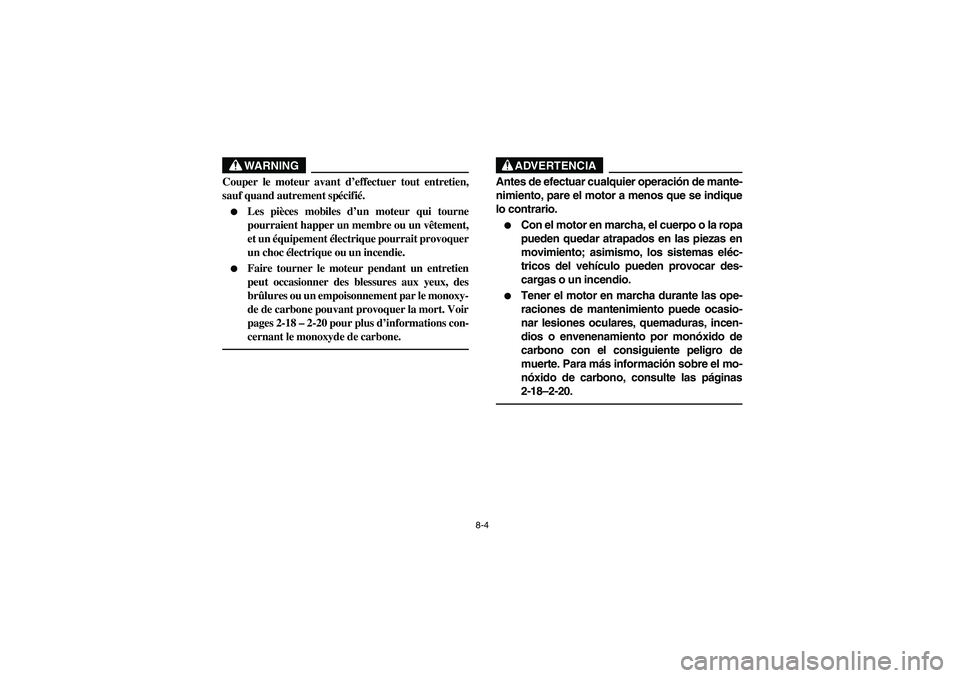Page 288 of 490
8-1
EVU00650
1 -PERIODIC MAINTENANCE AND
ADJUSTMENTPeriodic inspection, adjustment, and lubrication
will keep your vehicle in the safest and most effi-
cient condition possible.
Safety is an obligation of the vehicle owner/opera-
tor. The most important points of vehicle inspec-
tion, adjustment, and lubrication are explained on
the following pages.
WARNING
Failure to properly maintain the vehicle or per-
forming maintenance activities incorrectly
may increase your risk of injury or death dur-
ing service or while using the vehicle. If you
are not familiar with vehicle service, have a
Yamaha dealer perform service.
EE.book Page 1 Wednesday, November 7, 2007 2:40 PM
Page 290 of 490
8-3
WARNING
Turn off the engine when performing mainte-
nance unless otherwise specified.�
A running engine has moving parts that
can catch on body parts or clothing and
electrical parts that can cause shocks or
fires.
�
Running the engine while servicing can
lead to eye injury, burns, fire, or carbon
monoxide poisoning – possibly leading to
death. See pages 2-17–2-19 for more infor-
mation about carbon monoxide.
EE.book Page 3 Wednesday, November 7, 2007 2:40 PM
Page 291 of 490

8-4
WARNING
Couper le moteur avant d’effectuer tout entretien,
sauf quand autrement spécifié.�
Les pièces mobiles d’un moteur qui tourne
pourraient happer un membre ou un vêtement,
et un équipement électrique pourrait provoquer
un choc électrique ou un incendie.
�
Faire tourner le moteur pendant un entretien
peut occasionner des blessures aux yeux, des
brûlures ou un empoisonnement par le monoxy-
de de carbone pouvant provoquer la mort. Voir
pages 2-18– 2-20 pour plus d’informations con-
cernant le monoxyde de carbone.
ADVERTENCIA
Antes de efectuar cualquier operación de mante-
nimiento, pare el motor a menos que se indique
lo contrario.�
Con el motor en marcha, el cuerpo o la ropa
pueden quedar atrapados en las piezas en
movimiento; asimismo, los sistemas eléc-
tricos del vehículo pueden provocar des-
cargas o un incendio.
�
Tener el motor en marcha durante las ope-
raciones de mantenimiento puede ocasio-
nar lesiones oculares, quemaduras, incen-
dios o envenenamiento por monóxido de
carbono con el consiguiente peligro de
muerte. Para más información sobre el mo-
nóxido de carbono, consulte las páginas
2-18–2-20.
EE.book Page 4 Wednesday, November 7, 2007 2:40 PM
Page 358 of 490
8-71
6. Wash the sponge material gently but thor-
oughly in parts cleaning solvent. WARNING!
Using gasoline or other flammable sol-
vents to clean the air filter element can
cause a fire or explosion, which could
lead to serious injury.
7. Squeeze the excess solvent out of the
sponge material. NOTICE: Do not twist the
sponge material when squeezing it.
8. Wash the sponge material in warm soapy
water to remove remaining solvent, then
rinse thoroughly with plain warm water.
9. Squeeze excess water out of the sponge ma-
terial. NOTICE: Do not twist the sponge
material when squeezing it.
10. Allow the sponge material to dry thoroughly.
Inspect the sponge material and replace it if
damaged.
EE.book Page 71 Wednesday, November 7, 2007 2:40 PM
Page 368 of 490
8-81 1. Bolt (× 3)
1. Vis (× 3)
1. Perno (× 3)
1
1. Tailpipe 2. Spark arrester 3. Gasket
1. Tube d’échappement arrière 2. Pare-étincelles
3. Joint
1. Tubo de escape 2. Parachispas
3. Junta
3
12
5B410018
Cleaning the spark arrester
WARNING
Hot exhaust system may cause burns. To
avoid burns or fires, make sure that the engine
is stopped and the exhaust system is cool be-
fore cleaning spark arrester. Do not start the
engine while cleaning the exhaust system.1. Remove the bolts.
2. Remove the tailpipe by pulling it out of the
muffler, and then remove the gasket.
3. Tap the tailpipe lightly, and then use a wire
brush to remove any carbon deposits from
the spark arrester portion of the tailpipe and
inside of the tailpipe housing.
4. Install the gasket, and then insert the tailpipe
into the muffler and align the bolt holes.
5. Install the bolts and tighten them to the spec-
ified torque.
EE.book Page 81 Wednesday, November 7, 2007 2:40 PM
Page 372 of 490
8-85
Brakes
Replacement of brake components requires pro-
fessional knowledge. Brake service should be per-
formed by a Yamaha dealer.
WARNING
Operating with improperly serviced or adjust-
ed brakes could lead to a loss in braking ability
and an accident.
EE.book Page 85 Wednesday, November 7, 2007 2:40 PM
Page 390 of 490
8-103
5B460004
Cable inspection and lubrication
WARNING
Damaged cables could restrict operation,
which may cause an accident or injury. Inspect
control cables frequently and replace dam-
aged cables. Corrosion can result when the
outer covering of control cables becomes
damaged. Cables can also become frayed or
kinked.Lubricate the cable ends. If the cables do not oper-
ate smoothly, ask a Yamaha dealer to replace
them.
Recommended lubricant:
Engine oil
EE.book Page 103 Wednesday, November 7, 2007 2:40 PM
Page 400 of 490
8-113
Tire replacement
Always use the same size and type of tires recom-
mended in this owner’s manual. The tires that
came with your Rhino were designed to match the
performance capabilities and to provide the best
combination of handling, braking, and comfort. It is
best to replace all four tires at the same time. If that
is not possible, you must replace the tires in pairs
(front or rear) with tires of the same size and type
as the originals. Never replace just one tire.
WARNING
Installing improper tires on your Rhino can af-
fect handling and stability. This can cause a
loss of control.The tires listed below have been approved by
Yamaha Motor Manufacturing Corporation of
America for this model.
Manufacturer Size Type
Front MAXXIS 25 × 8-12NHS M951Y
Rear MAXXIS 25 × 10-12NHS M952Y
EE.book Page 113 Wednesday, November 7, 2007 2:40 PM